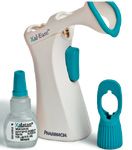Article
Mechanical aid assists in administration of drug
Author(s):
Chicago-The expense of latanoprost (Xalatan, Pfizer Ophthalmics) treatment may be driven down with the use of a relatively new device that assists patients in proper administration of the eye drops, according to a research team led by Sriram Sonty, MD, FACS, clinical associate professor, University of Illinois, Chicago Eye Center.

The Xal-Ease delivery system (Pfizer Ophthalmics) is a plastic, L-shaped mechanical device that houses a bottle of latanoprost on one end and sports an eyecup on the other. To use the device, the patient tilts the head back, positions the eyecup around the lid of the eye, and presses a button that causes the proper amount of medication to be dispensed.
The device is currently offered to patients free of charge.

Dr. Sonty said the cost of treatment is often driven higher by the inability of many patients to administer the proper dose to the eye, either through improper pressure on the bottle, improper placement of the drop, or because of physical infirmities preventing them from steady application.

To determine the effectiveness and patient reception of the device, Dr. Sonty and his colleagues provided 54 patients with glaucoma who were taking latanoprost with their own dispensers. Measurements were taken via a questionnaire that gathered information regarding comorbid conditions (arthritis and tremors); length of use; daily regular use; user-friendliness; drop delivery; reminding nature of the device; patient expectations/satisfaction; continued interest to use; reduction in refills/cost; recommendations to others; and opinion regarding development of similar devices for other medications.
Among the 47 patients who responded, 89% of patients reported that the device exceeded their expectations, that they intended to continue to use it, and they would recommend the use of it to others. Similarly high numbers of patients reported satisfaction with device efficiency (87%) and the desire to have a similar device for administration of other medications (85%). Seventy one percent reported that they used the device on a daily basis.
Among the drawbacks reported regarding the device included 58% of patients for whom the device did not serve as a reminder, and 23% who found it difficult to use, according to Dr. Sonty.
Newsletter
Don’t miss out—get Ophthalmology Times updates on the latest clinical advancements and expert interviews, straight to your inbox.




